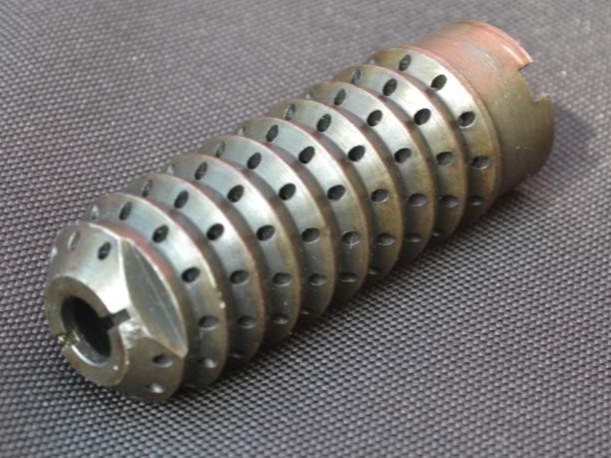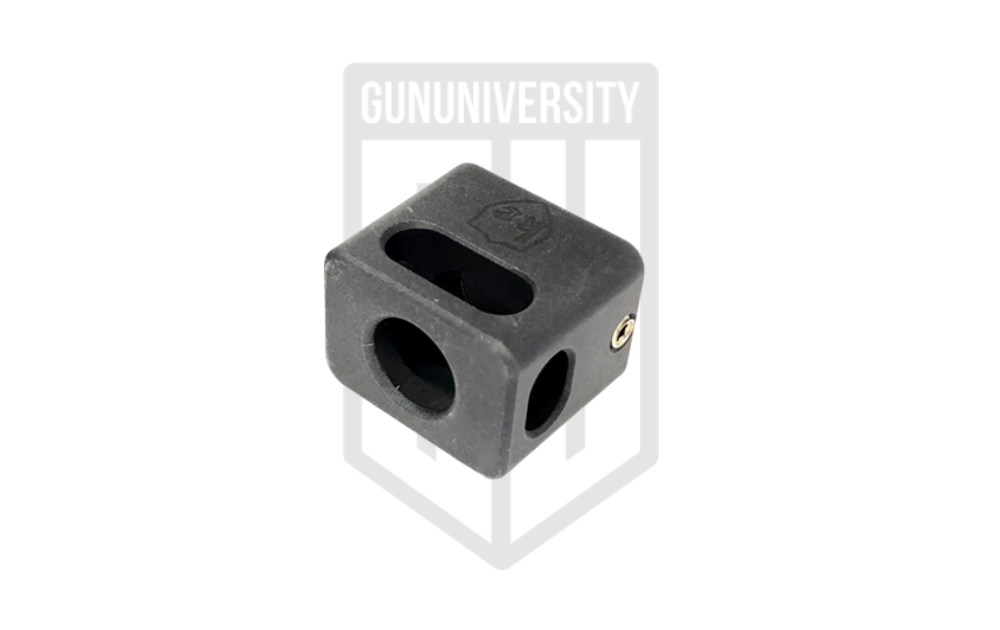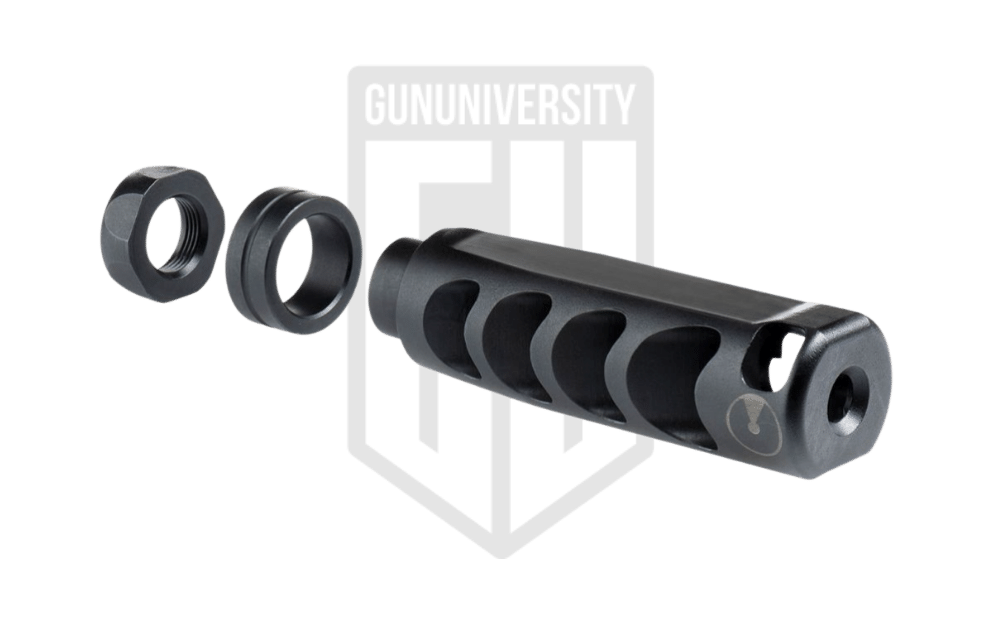Muzzle Brakes vs Compensators vs Flash Hiders
Today we compare muzzle brakes vs compensators vs flash hiders. If you look at the end of nearly any modern rifle, you likely see some form of muzzle device. Muzzle devices vary wildly these days, and it’s fairly impressive what a few ounces and a couple of inches can do to affect how your rifle functions. The main purpose of a muzzle device is to change your weapon’s behavior. There are four main types of muzzle devices. We have flash hiders, muzzle brakes, compensators, and suppressors. Of those four, three are basically legal and easily accessible anywhere.
Suppressors do require a tax stamp and a permission slip from the ATF prior to ownership. Flash hiders, muzzle brakes, and compensators have no federal laws regarding their use. I only know of one state that bans any of the aforementioned, and that’s California. They banned flash hiders because…well, reasons, I guess. Today we are going to discuss, compare, and contrast flash hiders, brakes, and compensators. In the end, I’ll even give you a few of my favorites in each category.
The Early History Of Muzzle Devices
Before World War 2, muzzle devices on small arms were not very common. The Thompson had the Cutt’s compensator. The FG42 had its unique muzzle device, and various machine guns had devices. After World War 2, they became quite common. The M-14 and M16, the AK, the FN FAL, the G3, and so basically every other rifle produced in this time frame had some form of muzzle device.


Since then, they’ve evolved, grown, and become a defining feature of modern rifles. If you have a threaded barrel, your rifle deserves to have a muzzle device. Let’s dive deep, and hopefully, we can help you figure out the right muzzle device for your rifle, PCC, or even your handgun.
Into the World of Muzzle Devices
Flash Hiders
I think the name is pretty self-explanatory here. Flash hiders are muzzle devices that disburse flash. What’s important to understand is who it disperses flash for. While it cuts the perception of flash from all directions a bit, it’s primarily used to reduce flash for the shooter. In low-light environments, flash can be distracting if not blinding. It’s annoying and doesn’t help with natural night vision.
Not to mention the use of NODs, Night Observation Devises AKA night vision goggles, which will amplify the muzzle flash even more. Flash hiders are very common on military rifles and are typically the best choice for those applications. The flash you see is the product of burning powder, so flash hiders often work best on rifles with full-length barrels. As barrels get shorter, flash does get more intense.
Flash hiders work by providing vents to redistribute that burning gas. Think of flash almost like water. It’s flowing down the barrel and will come out as a solid section. That produces a violent and large bubble of flash. A flash hider pops that bubble and dispenses it through a series of vents. The redirection of gas in multiple directions helps prevent flash from being so obvious and so disruptive to vision.
Flash hiders work well on rifles of all types. They are at home on bolt actions, semi-autos, single shots, and whatever else you have. They become more and more important when using shorter-barrel rifles. A flash hider can be quite handy on a rifle-caliber pistol or SBR. Flash hiders also tend to be simple and affordable muzzle devices.
The downsides to flash hiders are few and far between. Depending on the design, the flash hider may have an open bottom. Early M16 flash hiders and AK flash hiders like the Razr are very effective, but when shooting in the prone they throw debris everywhere, making them quite annoying. While they are more important on shorter-barreled weapons, they tend to be less effective on these short barrels.
Compensators
Compensators are designed to help reduce muzzle rise. When you fire the rifle rapidly, the barrel will start to climb and take you off target. It’s annoying and affects how rapidly you can place effective shots on target. Thread a compensator on your rifle, and you can reduce this climb and make it easier to keep your sights on target.
While they make most modern muzzle devices for rifles, compensators have found a home on pistols as well. They began life on competition pistols but have made their way to modern fighting pistols. Companies like SIG Sauer have even designed pistols like the XMacro with built-in compensators.
Compensators are muzzle devices that have ports facing upward. The compensator ports redirect the gas upward when the weapon is fired. When the gas goes upwards, it pushes against the solid bottom of the muzzle device. This creates a thrust that pushes the barrel downward. This results in a reduction of muzzle rise. It’s simple but effective.
There are also devices called linear compensators. These muzzle devices are designed to redirect the flash and noise forward of the shooter. They tend to be popular on short-barreled rifles. They make shooting these shorter-barreled weapons a bit more comfortable. Although, they do not offer the same muzzle rise-reducing benefits.
Compensators work best on semi-auto pistols and rifles. If you’re not taking a fast follow-up shot, there isn’t much of a purpose. On something like a manually operated bolt action, the compensator isn’t necessarily needed or really appreciated. Sure, it will work, but it’s like multiplying something by zero.
Compensators have a few disadvantages. When they redirect gas upwards, they can also redirect flash upward. This depends on the gun, caliber, ammo, and barrel length, but it is something to be aware of, especially when shooting with NODs. On handguns, this gas can be uncomfortable if fired from close retention and could cause burns if the gun is against your body when you fire.
Compensators are a great way to make your gun louder as well. You might not make friends at the range. Compensators also tend to be fairly expensive compared to flash hiders. Some can cost well over a hundred dollars.
Muzzle Brakes
Muzzle brakes add ports to the side of a muzzle device. They work a bit like compensators, but in the horizontal direction rather than the vertical direction. Muzzle brakes are popular on rifles, as well as large pieces of artillery and tank guns. These devices reduce recoil by redirecting gas. Recoil is the rearward motion of the rifle that impacts your shoulder.
These devices reduce recoil by using the gas to apply forward movement to the rifle. As the gas flows through the muzzle device, it hits the side ports of the muzzle brake. This gas hitting the brake ports creates forward movement. The gas applies the brakes to rearward movement, if you will. That’s where the name comes from. It’s clever and effective.
Muzzle brakes work well on any rifle. Their effects can be felt on semi-autos, bolt actions, lever actions, etc. Muzzle brakes really show their usefulness when used on high-recoiling calibers. They make a 5.56 AR 15 charming, but really work to tame lightweight, full-powered rifles. On .308s, they make a significant difference, and on guns in .50 BMG, they are downright necessary.
Muzzle brakes tame rifles, but at a cost. They can be expensive, especially for full-powered rifles. They are also fairly large for muzzle devices and will add a little weight to the gun. If you are at a public shooting range, get ready not to make friends.
These are the loudest muzzle devices on the market, and they also throw blast left and right of the shooter. It can be annoying to have a shooter beside you with a muzzle brake, so give your fellow shooters some room. At an indoor range, they can be downright brutal.
Hybrid Devices
There are many muzzle devices out there that blend the features of the listed muzzle devices. These can be entirely intentional or happy accidents. Muzzle devices like the VG6 Gamma are designed to work as both a brake and a compensator. They primarily designed other devices like the Birdcage flash hider for flash, but have the added effect of driving down muzzle rise.
Oftentimes, a hybrid device does one task primarily with the secondary effects of another. They also will probably be more expensive and longer than other devices, although not always. The aforementioned bird cage flash suppressor is both cheap and compact. Hybrid devices are a unique option that can give you two-for-one performance.
My Favorite Muzzle Devices
With all this said, if you need some advice on which muzzle device to get, I’m here to help! I have a few favorites that aren’t just my biased pics. These are high-performing devices that help tame flash, muzzle rise, and recoil, or maybe a bit of all of it.
Flash Hiders
Birdcage
They invented the traditional birdcage flash suppressor for the M16 series of rifles. They’ve remained in service with the United States military ever since. The birdcage is simple, affordable, and highly effective at reducing flash. You can get them for a few bucks, and they are a great muzzle device.
While we primarily used them on 5.56 rifles, over time the design has moved on to other calibers and platforms. People can now use the old birdcage on AKs, AR-10s, and 9mm carbines of all types. The simple design keeps things affordable and effective.
-
$6.79
-
$7.99
-
$6.79
Surefire Warcomp
Before the Birdcage, the M16 used a three-prong flash hider, and while it worked well, it was easily bent and broken. Surefire went back to the drawing board to produce the Warcomp. They reinforced the prongs to provide a stronger, more rugged design that won’t easily bend or snag. At the same time, it’s one of the most effective flash hiders on the market.
The Warcomp also adds a few ports for compensating to help keep your muzzle rise low. Sadly, the Warcomp is only produced for 5.56 and 7.62 caliber rifles, leaving out other calibers.
-
$140.20
-
$152.00
-
$159.99
Muzzle Brakes
SilencerCo ASR Muzzle Brake
The SilencerCo ASR Muzzle Brake is a dual-purpose design that incorporates a brake with a mounting system. The ASR Muzzle Brake acts as a quick detach device for several of SilencerCo’s suppressors. More than that, it offers you three ports on each side to catch gas and reduce recoil.
These three ports do wonders for recoil reduction and make the weapon much easier to control and handle. The ASR comes in a ton of designs, and it’s made for a wide variety of calibers, including 5.56, 7.62, .338, 9mm, and many more. It’s likely one of the most compatible muzzle devices on the market.
-
$78.20
-
79.90
-
79.90
-
$89.99
JP Recoil Eliminator
Do you ever see that big muzzle brake on a Barrett .50 BMG rifle? Well, JP Rifles had the same idea when they produced the Recoil Eliminator. While it only has two ports, the shape and size of those ports make it extremely effective at reducing recoil. JP Rifles makes some of the best competition rigs on the market, and their accessories match.
This is a big device, and it’s made to suck up recoil without any effort to keep the size or weight on the low side. If you want maximum performance, you have to go maximum in size. JP produces the Recoil Eliminator for AR 15 and AR 10 rifles but advertises that you can enlarge the hole to .416. You might need a machinist for that.
-
$94.96
-
$94.99
Compensators
Wilson Q Comp
Wilson took the general idea of the birdcage and made it bigger and better all around. This massive beast of a compensator is designed to drive your barrel downward with every shot. If you aim through a red dot, you will be tickled by how little the dot moves between shots. The Q Comp does wonders for muzzle rise and makes rapid-fire very controllable.
Wilson produces the Q Comp in three calibers. We have 5.56, .30 caliber, and even .458 SOCOM. You’re covered through a wide gamut of rifles, and believe it or not, the Q-Comp is an affordable option.
-
$59.95
-
$59.95
-
$68.19
KE Arms Carry Comp
While we’ve talked primarily about rifle muzzle devices, I can’t help but mention at least one compensator designed for pistols. The KE Arms Carry Comp is designed for 9mm handguns and provides a single port comp aimed at keeping your firearm short and easy to handle with a drastic reduction in muzzle rise.
This affordable muzzle device makes it easy to keep your sights on target for long strings of fire. It’s easy to attach and time. Plus, it’s supporting a small American company currently engaged in a legal battle with anti-gun advocates.
-
$62.96
Hybrid Devices
VG6 Gamma
The VG6 Gamma muzzle device blends both a compensator with a muzzle brake, with the primary focus being recoil reduction through the use of 1 to 2 side ports, depending on caliber. On top of the device, we have six holes aimed at reducing muzzle rise as well. For a standard 5.56 or PCC caliber rifle, these are tough to beat.
VG6 Precision makes the Gamma for a variety of calibers, including 5.56, 7.62, and 9mm. Plenty of opportunities for modern rifles. On top of that, these devices are affordable and widely available.
-
$46.71
-
$72.24
-
$69.99
-
$72.24
Ultradyne Apollo Max
If you want to reduce recoil as much as possible, then check out the Ultradyne Apollo Max. This device primarily exists to eliminate recoil absolutely and make your rifle downright soft shooting. This muzzle device features four massive ports that redirect as much gas as possible. Any that might have escaped will help keep the muzzle rise reduced via two forward ports.
The Ultradyne Apollo Max is a big device and is almost 3 inches long. Additionally, it’s an expensive device. It’s available for both 5.56 and .30 Caliber rifles.
-
$117.99
-
$139.99
-
$117.99
-
$127.99
What’s the Best Muzzle Device
My honest answer would be a suppressor. They reduce noise, flash, recoil, and muzzle rise. However, they are expensive, require a tax stamp, and your state might just not allow them to begin with. So with that in mind, my best advice is to match your muzzle device to your weapon and goal. Do you need to hide the flash due to a short barrel? Is your lightweight magnum a shoulder kicker? Or are you trying to put shots on target as quickly as possible?
It’s all worth considering before hitting the buy it now button.
Looking for more information on muzzle brakes and compensators? Check out our article on the Best AR-15 Muzzle Breaks and Compensators.
Recent Posts
December 8, 2025
November 29, 2025
November 25, 2025
November 22, 2025












